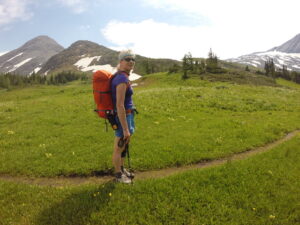Alison Andrews – ACMG Mountain Guide

ACL repair and rehab for “Dummies”
ACL surgery and rehab information for the rookie; from one who has been there too many times over the last 30 years.
The Accident
Not all ACL injuries are the big cartwheeling ski crash that makes for terrifying video footage. ACL tears can happen quite easily if in just the right, or wrong, body position. The feeling of a pop is a pretty good telltale sign.
Directly after the injury, I’ve had my knee be totally stable once, slightly unstable once, and very unstable once.
Stability is not a sign of an intact ACL.
Unless a medical practitioner tests a lot of ACL’s, it can be difficult to be good at it. Several times, by different doctors, I had been told my ACL was fine, when in fact it was completely torn. Visit a sports physio or doctor if there could be any doubt.
After the diagnosis and waiting for surgery

Surgeons want to operate on a knee with no swelling and surrounded by lots of strong muscles. To this end, faithfully do all the exercises your physiotherapist or Doctor gives you. Use ice, compression and elevation to help get rid of any swelling. Riding a bike seems great for getting rid of swelling.
— Access Banff Sport Medicine’s “Prehabilitation” Protocol here —
If you haven’t torn any meniscus, you want to keep it that way for the longevity of a healthy knee. This means doing only activities given the green light by your doctor or physiotherapist. Usually these are straight ahead, in-line activities like walking, road biking or perhaps classic nordic skiing on flat trails.
If you are strong and have the swelling under control, perhaps you’ll be lucky enough to get a cancellation earlier than your original surgery timeline.
The long awaited surgery day
They will likely want you at the hospital 3 hours before your surgery. While you wait, seemingly forever, a nurse will hook up an IV, the surgeon will visit and answer any questions, and the anesthesiologist will discuss anesthesia options with you. If you choose to be awake, you will be able to watch the surgery on a monitor, if you are so inclined. Personally, I like watching so I understand what is being done to my knee. Perhaps I’m a closet wanna-be surgeon?
After waiting a few more hours after surgery, you will likely be sent home, with someone else driving you. You will probably have a prescription for pain killers. I suggest that this is filled before heading for home. You may be desperate for them, you may never touch more than acetaminophen or ibuprofen, but if you need strong painkillers in the middle of the night, you will be mighty glad that prescription was filled. I have been on both ends of the spectrum. Huge, agonizing pain that broke through the narcotics after one surgery and almost no pain, that was easily handled by acetaminophen and ibuprofen, after another surgery.
— Learn more about managing your pain after surgery —
The long road to recovery
The first week is the hardest. You should be resting, icing and elevating your surgery leg and time dribbles by so slowly.
Each week after that, time marches a bit faster, as you can get out and about more. It is super helpful to have a sedentary project that engages you while you have extra time on your hands. I have studied German, French and done volunteer research. Musical instrument playing would be a good choice, except that I have about as much aptitude as a stone.
Here is the most important thing!! When first placed in your knee, the new graft is fairly strong. The bad news is that the graft loses strength for the first 8 weeks and then slowly starts to regain strength. This is critical to understand. Your knee feels better and better, your muscles are getting stronger and stronger, yet the graft that holds it all together is more like tissue paper.

— Learn more about the biological recovery of the graft —
That is why you can ONLY do the activities and exercises prescribed by your surgeon or physiotherapist. If in doubt about a stretch, strength exercise or activity, please get the OK before going ahead. Even if you don’t tear your graft, you may stretch it out, which gives you a knee with too much movement in the joint.
For this recovery, patience is a necessary virtue.
Rejoice in the milestones and the things you can do; your first walk outside with the sun on your face, driving, riding a bike outside (which feels so normal!).
With a bit of luck (no slips on slippery surfaces), diligent attention to the rehab protocols, and time, you will have a knee that is good to go once again.
Alison’s advice on rehab….
English Subtitles
French Subtitles
Tagalog Subtitles
Learn more about Alison’s journey in this video

